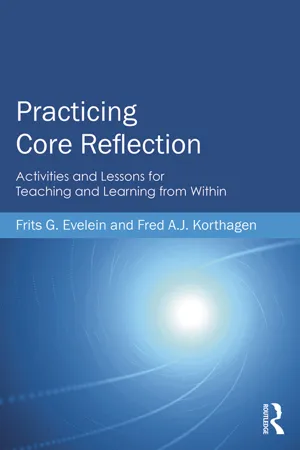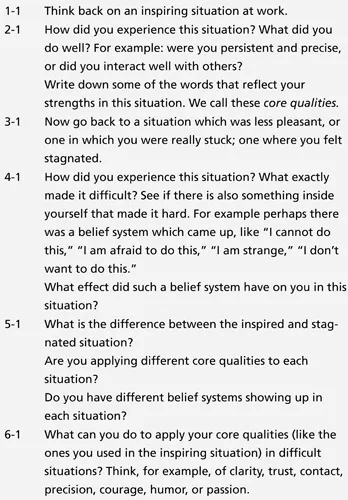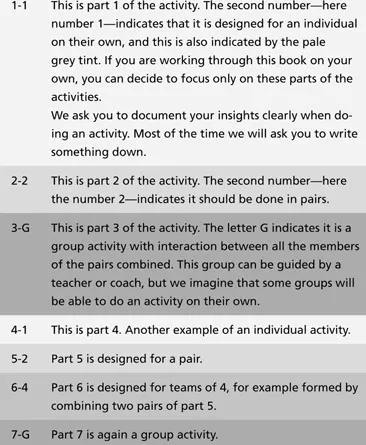![]()
1
Working From your Inner Core
An Outline
Jim has just started his first teaching job. He still feels young and inexperienced when dealing with students, so he has a somewhat hesitant attitude. In the classroom he tries to do his best but seems a bit withdrawn. However, he gradually notices that the students like his openness and his experiments with a more creative approach. Slowly, he puts more creativity into his lessons and instructional methods. The students love it.
This book is for all people working in education who want to realize their full potential and to enjoy their work. It is very suited for teachers and other professionals who are experienced and good at their work but who feel they could benefit from further professional development, and for those in structured professional development programs. This book is all about teaching and learning from within, using all of your strengths and talents. Finding this core potential inside yourself and using it in your work can be very beneficial to all current or future roles you might have in education.
In the example above, we see how Jim is initially quite withdrawn in his teaching. But he recognizes quickly that he has a lot to offer. He shows that he has many fresh ideas which are appreciated by the students. His creativity shows up when it comes to designing new ways of working, a personal quality making him a strong professional. Slowly, he also starts utilizing another quality, that of courage; the courage to be who he is and to use what he has to offer, for example his creativity. This is a personal quality he possessed before but did not use. He starts using it more, and this earns him more appreciation from his students.
At the core of this book is the understanding that many people have important personal qualities which they are not fully utilizing in their work. Often much more is possible than is realized. It is useful to start with the question: Do you know your core qualities and talents and can you apply them? Or are you blocked in doing this? If so, can you let go of these blocks and optimally apply your qualities? Having an understanding of this helps enormously in developing yourself.
1 Introductory Activity: Reflection on Inspiration and Stagnation
This activity helps you to explore your core qualities.
Introductory Activity: Reflection on Inspiration and Stagnation
In this book we will not only explain what it means to work from within, but will also help you to experience it. This book is, first of all, a practical handbook using activities to help you discover who you are and how you can apply your core qualities at work. How can you utilize your personal strengths so that you can be and remain inspired? How can you be most effective in your work?
The Possible Applications of This Book
This book is about professional development in education, but not just for one type of career. What we will be learning can be applied to all types of work and to many contexts. Many elements of this book can, for example, be utilized to improve your teaching, classroom management, and leadership but also for coaching and training, programs focused on professional development, career counselling, professional workshops, personal reflections, writing a portfolio or CV, etc.
An assumption underlying this book is that, ideally, professional and personal growth go hand in hand and that the combination of these two will help you find your own personal strengths, since the most powerful professionals are shaped by a strong connection between who they are and their professional behavior.
The Vision
We, the authors of this book, have been working with student teachers, experienced teachers, educational leaders, and people from many other backgrounds and professions. While doing this, we started to recognize how simple ideas and exercises can often have a huge impact on professional development. They can show people a very beneficial development route that they have never seen before. We have found that a lot of human potential is underutilized because people do not know what is possible. It is amazingly inspiring to see the dormant potential of a person suddenly take shape and be recognized. That is why this book aims to connect the personal and the professional.
We have also discovered that many misconceptions exist about this connection of the person and the profession. For example, often people’s perception is that something is wrong with you if you look to others for support regarding a personal struggle at work or home. It is our belief, however, that asking for support is a great way to turn silver into gold. The most powerful people are the ones who realize that you never stop learning and that continuous development should be supported professionally.
Another misunderstanding is that ‘working on yourself’ is hard and will bring up traumatic experiences from your youth. This thought pattern seems to stem from a long-expired understanding dating back to the work of Freud, which stubbornly remains in our collective thinking. True, psychology has for a long time focused on finding and ‘treating’ youth traumas and wounds, but to a large degree this thinking has now been replaced by the concept of tapping into innate strengths and inner potential. Personal development has become an area of inspiration and joy and can lead to strong professional growth.
One of the authors of this book, Frits Evelein, is familiar with the world of music and music education. He has even made this his career. Art shows how using your own creative potential can sometimes lead to new developments, which you would never have thought possible. Art also shows that a playful and joyful attitude is important in this. Hence, working on your professional development does not have to be a serious and heavy experience. By playfully exploring new elements that present themselves, you can discover new opportunities that seem unheard of. Just think about a group of musicians who come together to have fun and make music. They can create an enormous feeling of ‘flow’ and produce amazing music. Using the example of music, we may ask you: How are you going to make your music at work, and in doing so, have fun with others? The activities in this book give you many opportunities to discover more about this. Much more is possible than you can dream of; our traditional thought patterns about ourselves are often our biggest stumbling blocks.
Of course, sometimes it can also hurt to realize how you have slowly moved away from your core—from who you really are—and this can even bring up melancholic memories about the time you were an innocent child. These feelings are a normal part of learning to work and live according to your core. Most people who are looking to make more use of their talents and qualities will go through this process at some point; it is a major step toward working and living in agreement with who you are.
The Structure of This Book
Each chapter of this book is written around a specific theme connected to professional development. We base our writing on the latest scientific developments, because recently, much research has been done around this topic. Over the last decade, a lot has been learned about human potential, some of which is rediscovered knowledge which has existed for thousands of years and is now translated for our time. Completely new discoveries are also being made and have led to new theories that are directly applicable to professionals, and can have a big impact on your daily work.
Although this book is based on scientific research, this research is not our main or only focus in the chapters. Rather we start from the perspective of everyday personal experiences at work or gained during professional training activities. To support this, the first part of each chapter will describe the chapter theme from an everyday perspective and will contain one or more practical activities (like the activity above), which may help you to recognize the theme in your work situation, your training, or at home. They are called ‘introductory activities’ and are aimed at connecting your personal experiences with scientific concepts.
Following the practical introduction, each chapter contains a section called ‘Further exploration.’ This section will deepen your understanding of the ins and outs of the theme and is especially aimed at making the connection between you and your daily experiences at work. You can do these activities on your own, in groups of two, or four, or in a larger group.
Each chapter ends with a section called ‘Scientific background,’ in which we briefly reflect back on the chapter theme from a scientific perspective and help you find sources that support or deepen the theme of the chapter. Everything in this section will be referenced. These references could help you to find further information if you are looking for more detail. We will keep this section of each chapter short and concise, as we think the most valuable aspect of this book is the focus on experience and practical application. For anyone looking for more theoretical detail it is useful to know that the approach that lies at the core of this book is further developed in the theory of core reflection. This theory has been summarized in the book Teaching and learning from within (Korthagen, Kim, & Greene, 2013). This book also discusses a variety of practical applications of core reflection, as well as empirical studies on the resulting learning processes and learning outcomes in professionals. More background information and references to other publications and workshops can be found on www.korthagen.nl.
Finding Your Way Through the Activities
All of the activities in this book will help you to become aware of your own qualities and those of others, to strengthen those qualities, and to let go of blocks that may be limiting you. It would be possible to mix up the activities and use them in any order, but we think you would benefit from doing some of the introductory activities first. These are clearly indicated at the start of each chapter. They are short, stand-alone activities to help you understand an aspect of the theme. The different aspects will be expanded on in the rest of the chapter.
Table 1.1 Examples of questions that the activities can help you with See Chapter 10, Table 10.1 for a more detailed overview.
| # | Example of question | Description of activity |
|
| 1 | How do I improve my focus and concentration? | Improving your focus (19, 20, 68), concentration, perception, and precision (9,12) |
| 2 | How do I recognize my own and others' qualities? | Recognizing core qualities (2, 3, 4, 5, 6, 7, 8) and learning to give feedback (14) |
| 3 | How do I limit myself in what I do? | How are you unconsciously limiting your own power (48, 60) and growth (29), and how can you change this (12, 53, 61, 62)? |
| 4 | What choices do I make (or not) and what are my dilemmas? | What choices do you make and why (25, 31, 34, 38, 39)? How do you deal with dilemmas (48, 49, 54)? |
| 5 | What are my ideals, what drives me, and what are my values? | Discover you ideals (36, 37), how they can stimulate your growth (38, 39), whether you are (un)faithful to them (40) and which values you apply (10). |
We also think that you would benefit from reading and practicing with concrete personal experiences and questions in mind, arising from your experiences at work or in training settings. In this way, you can use your work or training to feed your qualities. To support you in this, Table 1.1 lists some themes or questions people often have from professional experience, training, or their private life. For each theme, we list some activities from the book that can help you deal with the problem related to the theme. A larger overview of themes and related activities is given in Chapter 10 (Table 10.1).
The Structure of the Activities
Although the activities can be partly performed on your own, they are more beneficial when done in pairs, teams of four, or a large group. Each part of every activity indicates how many people it is designed for. An activity could, for example, have the following structure:
Example structure of an activity
Goal: This describes the goal of the activity.
Materials: Here we indicate which materials are best for you to use. Most of the materials are included in a pdf format on the website: www.routledge.com/9780415819961
In Chapter 10, more descriptions are given on how to use the activities, how to form pairs or teams, and how to work with larger groups.
Materials for the Activities
Linked to this book are many materials and tools for the activities. They can be found on the website at: www.routledge.com/9780415819961. Click on the eResource tab for access to the material. These tools are:
- Cards: You can print a pdf of all cards that are used for the activities. Cut the cards along the lines, and if you use the cards often (e.g. if you work with many groups) you can laminate the page before cutting out the cards. Each set of cards can be held together with an elastic band.
- Figures: Figures from this book.
- Tables: Tables from this book.
- Forms: The forms are also available on the website.
NOTE: Throughout the book, the URL for the website is designated with the symbol @.
The Topics of the Chapters
We will now give a brief outline of all the chapters.
Chapter 2 is called Tapping into the Power of Your Core Qualities. Examples of core quali...


